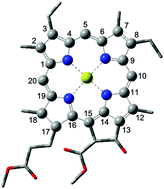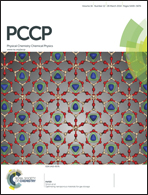Modeling the NMR signatures associated with the functional conformational switch in the major light-harvesting antenna of photosystem II in higher plants†
Abstract
The major photosystem II antenna complex, LHCII, possesses an intrinsic conformational switch linked to the formation of a photoprotective, excitation-quenching state. Recent solid state NMR experiments revealed that aggregation-induced quenching in 13C-enriched LHCII from C. reinhardtii is associated with changes to the chemical shifts of three specific 13C atoms in the Chla conjugated macrocycle. We performed DFT-based NMR calculations on the strongly-quenched crystal structure of LHCII (taken from spinach). We demonstrate that specific Chla–xanthophyll interactions in the quenched structure lead to changes in the Chla13C chemical shifts that are qualitatively similar to those observed by solid state NMR. We propose that these NMR changes are due to modulations in Chla–xanthophyll associations that occur due to a quenching-associated functional conformation change in the lutein and neoxanthin domains of LHCII. The combination of solid-state NMR and theoretical modeling is therefore a powerful tool for assessing functional conformational switching in the photosystem II antenna.


 Please wait while we load your content...
Please wait while we load your content...